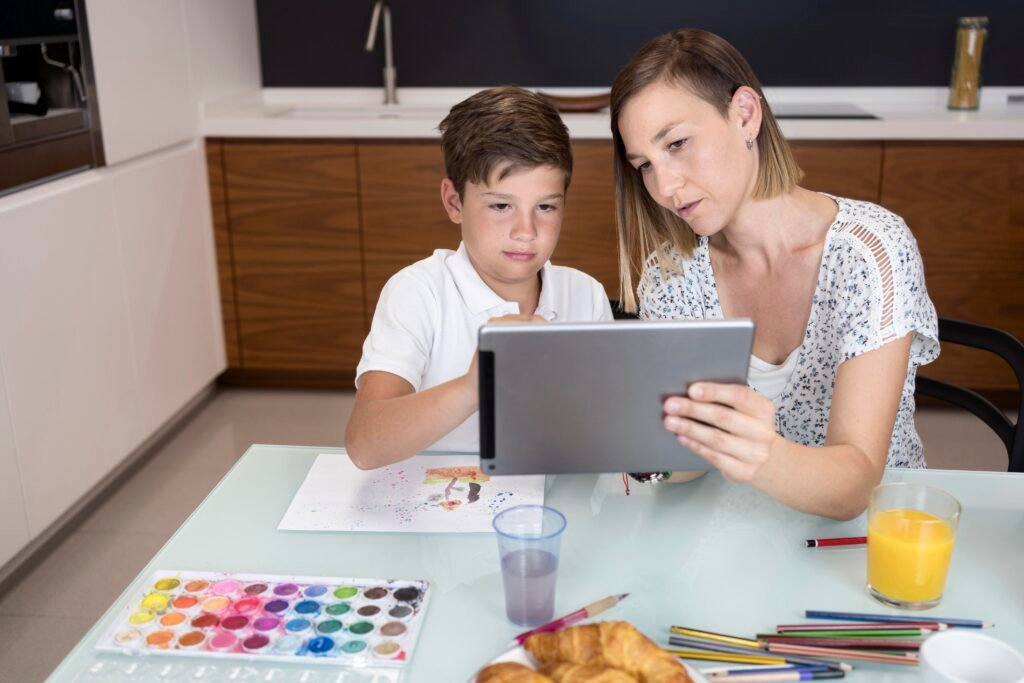Media exposure in preschool children presents the masses with both an opportunity for developmental stimulation and a risk for overstimulation. In today’s digital world, screens are certainly unavoidable, whether it be televisions, smartphones, tablets, or computers. A young child’s brain is rapidly developing, and this exposure to media and technology can play a crucial role in shaping early learning experiences. When used wisely, age-appropriate and interactive media can aid in language development, executive functioning, and social skills. However, excessive or unsupervised exposure can overwhelm the cognitive systems of children and result in developmental stagnation (Barr, R., et. al, 2024).
Read More: Can spinal cord stimulation help with depression without using medication?
The Potential Benefits of Media in Early Development
Thoughtful moderation and active selection can enable media to serve as a useful developmental resource. Well-designed preschool educational programs and applications come with engaging stories, interactivity, and repetition, all of which resonate with children’s learning.
- Language acquisition: For a long time, Sesame Street and numerous other programs have proven to assist in vocabulary and literacy development. Well-structured phonological and story comprehension programs for preschoolers enhance their story comprehension.
- Executive functioning: Some interactive apps with stories encourage the development of memory, problem-solving, and sequencing, which builds executive functioning.
- Social competence: Cooperation and empathy boosting media, in addition to role-play media, can help nurture perspective-taking and other prosocial skills.
These benefits, however, are not automatic. They are gradual and largely depend on media usage, the content consumed, and the involvement of caregivers or parents(Paediatrics & Child Health, Volume 22, 2017).
Read More: Media Psychology: Influence of Media on Behaviour and Perception
The Role of Joint Media Engagement (JME)
An established conclusion of developmental research is that children benefit more from learning when an adult guides them. Joint Media Engagement (JME) is the practice of parents or caregivers viewing or playing media alongside children, and it greatly enhances the positive impacts of screen time.

Caregivers can assist children in transposing information from a screen to the real world through asking questions, relating real-life scenarios to the screen content, and stimulating conversations. For example, parents can strengthen counting skills by repeatedly counting objects with the child after seeing a character do so on a show. JME serves two purposes:
- JME assists children in overcoming transfer deficits, which refers to the challenge young children face in applying information learned from a screen to the real world.
- It changes the passive consumption of information through a screen into active participation, turning what is meant to be individual engagement into a joint social interaction (Littlepage, M.K., 2025).
Read More: Is Screen Time Stealing Our Children’s Words?
The Risks of Overstimulation
The other side of exposure to media is the risk of overstimulation. Preschoolers are still in the stage of cognitive development. High intensity or poorly designed media can put stress on these developing cognitive Research indicates that rapid scene changes, the introduction of loud sounds, and fast-paced editing (as is common in cartoons and action-based content) can lead to shortened attention spans. Sustained focus, inhibitory control, and the gradual development of executive functioning could be compromised over time (Littlepage, M.K., 2025 & Christakis, D.A., et. al., 2018). Other risks include:
- Disrupted neural connectivity: Excessive screen time while watching TV and using the internet can change neural pathways that are responsible for attention in self-regulation and make it harder to self-regulate (e.g., triggering the attentional network).
- Behavioural challenges: Dysregulation can lead to irritability, hyperactivity, or difficulty calming down.
- Reduced play and interaction: Lack of active and imaginative play and social interaction can lead to reduced face-to-face interaction and play.
Beyond these cognitive risks, excessive screen time also leads to physical health problems like exposure to blue light interfering with sleeping and leading to poor sleep quality, in addition to increased BMI (body mass index) due to a sedentary lifestyle (Fitzpatrick, C., et. al, 2023 & Bozzola, E., et. al, 2018).
Read More: Social Psychology: The Landscape of Human Interaction
Parental Mediation as a Protective Factor
Parental or caregiver engagement directly correlates to balanced media interaction. Children who have media engagements with their caregivers are not only protected from overstimulation but also receive enriched learning opportunities. Effective strategies include:
- Setting limits: Daily screen-time practices need to be regulated with clearly defined boundaries.
- Choosing high-quality content: Educational shows and apps that match the child’s age or developmental needs need to be chosen.
- Active co-viewing: Parents need to actively engage with the material by discussing the plot and asking questions that encourage the child to add and connect the general ideas to everyday life.
- Integrating media into routines: Learning can be reinforced by integrating real-life and digital activities, such as drawing the character after watching the show.
Children do best when screen time is balanced with real-world learning and activities. Active parenting that combines the virtual and physical worlds is linked with advanced executive functioning and improved social-emotional development (Zoromba, M. A., et. al, 2023).
Read More: Virtual Autism Alert: Dangers of Excessive Screen Time for Your Toddlers’ Development
The Importance of a Balanced “Media Diet”
Just like nutrition, the use of media requires balanced moderation and quality. Leading paediatricians, such as the American Academy of Paediatrics, propose a screen time of 1 to 2 hours for preschool children. They also recommend that children be encouraged more to engage in activities such as reading, outdoor play, and social interactions as opposed to screen-time activities (Norwegian University of Science and Technology, 2019 & Paediatrics & Child Health, Volume 22, 2017). A healthy media diet emphasises:
- Quality over quantity: Interactive, slow-moving, educational content is better than passive entertainment.
- Variety of activities: Screen time should complement, not replace, storytelling, imaginative play, and physical activity.
- Regular consistency: Media consumption should not disrupt social interactions, sleep, or meals (9.1).
By using technology responsibly, parents can also serve as role models for good media habits.
Read More: Four Ways Social Media Can Be Good for Mental Health
Media Exposure and Social-Emotional Development
The media has a significant impact on children’s social-emotional development in addition to cognitive effects. Interactive content can foster cooperation, empathy, and healthy emotional expression in children. Children can learn how to handle conflict positively by watching shows where the characters demonstrate kindness or problem-solving skills.

Unsupervised exposure to violent or aggressive media, on the other hand, has the opposite effect and can increase aggressive tendencies, fear, or desensitisation. Children’s social behaviour is often shaped by the emotional modelling they observe online, highlighting the importance of parental supervision and mindful content selection.
Read More: Role of Play in Child Development and Emotional Expression
Cross-Cultural Insights on Media and Preschoolers
The role of media in children’s lives varies depending on the culture, according to research. For example, while children may have more unsupervised access in some parts of North America, educational screen time is highly valued but closely monitored in some Asian households. In multigenerational households in India, televisions and cell phones frequently provide entertainment, occasionally taking the place of face-to-face interactions between adults and children.
Carefully localising educational programming, as seen in shows like Galli Galli Sim Sim, can significantly enhance preschool literacy and numeracy skills (the Indian version of Sesame Street). These cross-cultural observations serve as further evidence that the influence of media is not universal and is largely influenced by socioeconomic, cultural, and familial norms.
Read More: How does the media influence aggression?
Clinical and Educational Implications
Educators, policymakers, and clinicians must comprehend the dual nature of media exposure. Instead of categorically discouraging media, developmental specialists should prioritise contextualised guidance. Teachers can carefully incorporate digital tools into their lessons, utilising them to enhance rather than replace practical exercises. When assessing children for attention or behavioural problems, clinicians should take media habits into account, acknowledging that excessive or subpar screen time may be a contributing factor. In the meantime, policymakers should support parent digital literacy initiatives and guarantee that easily accessible, high-quality educational media is widely accessible.
Future Directions and Research Needs
Although significant progress has been made in the field, more longitudinal research is needed to understand the lasting effects of early media exposure. There are still unanswered questions regarding:
- The ideal amount of screen time for various developmental stages.
- How new technologies, like virtual reality, affect preschool education.
- Strategies to guarantee that families from all socioeconomic backgrounds have fair access to high-quality media.
Working together, developmental psychologists, educators, and media creators can improve policies and create child-centred platforms that optimise advantages and reduce hazards.
Conclusion
Preschool children’s exposure to media has two drawbacks. It can enhance early development by promoting language acquisition, executive functioning, and social-emotional learning if handled with care. Without boundaries, supervision, and mindful content choices, it can lead to overstimulation, causing attention issues, reduced social play, and negative physical effects. A well-chosen media diet, integration with real-world activities, and active parental mediation are the keys to finding balance.
For families, this means treating digital media as just one tool for play and learning, not the primary means of communication. As technology develops further, society must make sure that the media serve children’s interests rather than their detriment. With evidence-based guidance, cultural sensitivity, and ongoing research, preschool media exposure can shift from a hidden risk to a powerful developmental tool.
Read More: Empower Yourself: The Art of Setting Boundaries in Everyday Life
FAQs
1. How much screen time is safe for preschool children?
Experts such as the American Academy of Paediatrics recommend no more than 1–2 hours of high-quality screen time per day for preschool children.
2. What type of media is most beneficial for young children?
Slow-paced, educational, and interactive programs or apps for preschoolers are most effective, especially when promoting problem-solving, language growth, and cooperation.
3. Why is parental involvement important during media use?
When parents co-view or co-play with children, they ask questions, connect screen events to real life. It turns passive viewing into active learning and reduces the risks of overstimulation.
4. What are the main risks of excessive or inappropriate media exposure?
Excessive exposure can lead to attention difficulties, reduced self-regulation, poor sleep, limited imaginative play, and even physical health issues such as higher BMI.
5. How can parents create a healthy media routine for preschoolers?
By setting limits, choosing age-appropriate content, co-viewing media, and balancing screen time with reading, outdoor play, and face-to-face interactions.
References +
Barr, R., Kirkorian, H., Coyne, S., Radesky, J. (2024). Early Childhood and Digital Media. Cambridge University Press. https://doi.org/10.1017/9781108885751
(2017). Screen time and young children: Promoting health and development in a digital world. Paediatrics & Child Health, Volume 22, Issue 8, Pages 461–468. https://doi.org/10.1093/pch/pxx123
Littlepage, M. K. (2025). Mitigating the Negative Effects of Over and Early-Exposure to Media with Joint Media Engagement: A Literature Review. Murray State’s Digital Commons. https://digitalcommons.murraystate.edu/ktej/vol11/iss2/9
Christakis, D. A., Ramirez, J. S. B., Ferguson, S. M., Ravinder, S., & Ramirez, J. (2018). How early media exposure may affect cognitive function: A review of results from observations in humans and experiments in mice. Proceedings of the National Academy of Sciences, 115(40), 9851–9858. https://doi.org/10.1073/pnas.1711548115
Fitzpatrick, C., Binet, M., Cristini, E., Almeida, M. L., Bégin, M., & Frizzo, G. B. (2023). Reducing harm and promoting positive media use strategies: new perspectives in understanding the impact of preschooler media use on health and development. Psicologia Reflexão E Crítica, 36(1). https://doi.org/10.1186/s41155-023-00262-2
Bozzola, E., Spina, G., Ruggiero, M., Memo, L., Agostiniani, R., Bozzola, M., Corsello, G., & Villani, A. (2018). Media devices in pre-school children: the recommendations of the Italian pediatric society. The Italian Journal of Pediatrics/Italian Journal of Pediatrics, 44(1). https://doi.org/10.1186/s13052-018-0508-7
Zoromba, M. A., Abdelgawad, D., Hashem, S., El-Gazar, H., & Aziz, M. a. a. E. (2023). Association between media exposure and behavioural problems among preschool children. Frontiers in Psychology, 14. https://doi.org/10.3389/fpsyg.2023.1080550
(2019). The potential impacts of preschoolers’ use of touchscreen devices on learning and growth. Norwegian University of Science and Technology. https://ntnuopen.ntnu.no/ntnu-xmlui/bitstream/handle/11250/2613750/no.ntnu:inspera:2301050.pdf?sequence=1
Anderson, D. R., Subrahmanyam, K. (2017). Digital Screen Media and Cognitive Development. The American Academy of Paediatrics. https://doi.org/10.1542/peds.2016-1758c













Leave feedback about this